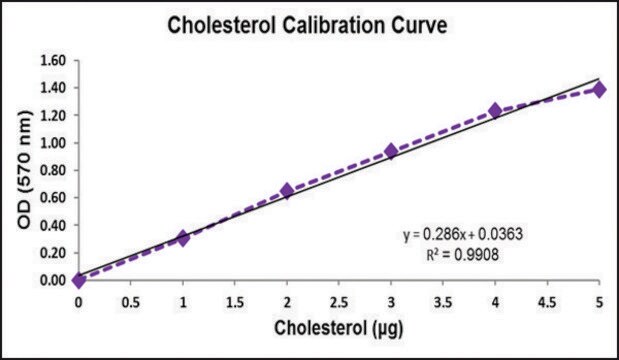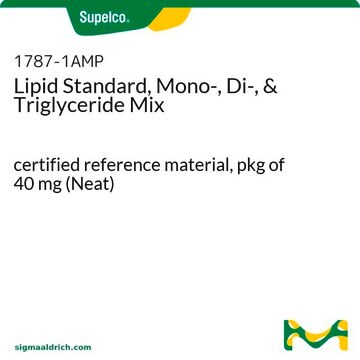추천 제품
사용
1 kit sufficient for 250 tests
저장 온도
2-8°C
유사한 제품을 찾으십니까? 방문 제품 비교 안내
일반 설명
The Serum Triglyceride Determination Kit is for the quantitative enzymatic measurement of glycerol, true triglycerides, and total triglycerides in serum or plasma at 540 nm. Triglycerides, esters of fatty acids and glycerol,1 do not circulate freely in plasma, but are bound to proteins and transported as macromolecular complexes called lipoproteins.2 Methods for triglyceride determination generally involve enzymatic3 or alkaline4 hydrolysis of triglycerides to glycerol and free fatty acids, followed by either chemical or enzymatic measurement of the glycerol released.
애플리케이션
A Serum Triglyceride Determination Kit was used to determine the level of triglycerides in whole-body homogenates of Drosophila melanogaster.
The Serum Triglyceride Determination Kit can be used for the measurement of glycerol, true triglycerides, or total triglycerides in serum or plasma. The procedure involves enzymatic hydrolysis by lipase of the triglycerides to glycerol and free fatty acids. The glycerol produced is then measured by coupled enzyme reactions. Many of the triglyceride reagents which are commercially available, do not differentiate between endogenous glycerol and glycerol derived by hydrolytic action of lipase on glycerides.
Triglycerides are first hydrolyzed by lipoprotein lipase to glycerol and free fatty acids. Glycerol is then phosphorylated by adenosine-5′-triphosphate (ATP) forming glycerol-1-phosphate (G-1-P) and adenosine-5′-diphosphate (ADP) in the reaction catalyzed by glycerol kinase (GK). G-1-P is then oxidized by glycerol phosphate oxidase (GPO) to dihydroxy-acetone phosphate (DAP) and hydrogen peroxide (H2O2). Peroxidase (POD) catalyzes the coupling of H2O2 with 4-aminoantipyrine (4-AAP) and sodium
N-ethyl-N-(3-sulfopropyl) m-anisidine (ESPA) to produce a quinoneimine dye that shows an absorbance maximum at 540 nm. The increase in absorbance at 540 nm is directly proportional to triglyceride concentration of the sample.
Triglycerides are first hydrolyzed by lipoprotein lipase to glycerol and free fatty acids. Glycerol is then phosphorylated by adenosine-5′-triphosphate (ATP) forming glycerol-1-phosphate (G-1-P) and adenosine-5′-diphosphate (ADP) in the reaction catalyzed by glycerol kinase (GK). G-1-P is then oxidized by glycerol phosphate oxidase (GPO) to dihydroxy-acetone phosphate (DAP) and hydrogen peroxide (H2O2). Peroxidase (POD) catalyzes the coupling of H2O2 with 4-aminoantipyrine (4-AAP) and sodium
N-ethyl-N-(3-sulfopropyl) m-anisidine (ESPA) to produce a quinoneimine dye that shows an absorbance maximum at 540 nm. The increase in absorbance at 540 nm is directly proportional to triglyceride concentration of the sample.
The triglyceride and free glycerol kits are for the quantitative determination of glycerol, total triglycerides or free triglycerides.
포장
The kit also includes sufficient reagent for an additional 250 free glyceride tests for true triglyceride determination.
적합성
Suitable for the quantitative determination of glycerol, total triglycerides or free triglycerides in serum or plasma
원리
The Serum Triglyceride Determination Kit can be used for the measurement of glycerol, true triglycerides, or total triglycerides in serum or plasma. The procedure involves enzymatic hydrolysis by lipase of the triglycerides to glycerol and free fatty acids. The glycerol produced is then measured by coupled enzyme reactions. Many of the triglyceride reagents which are commercially available, do not differentiate between endogenous glycerol and glycerol derived by hydrolytic action of lipase on glycerides. Triglycerides are first hydrolyzed by lipoprotein lipase to glycerol and free fatty acids. Glycerol is then phosphorylated by adenosine-5′-triphosphate (ATP) forming glycerol-1-phosphate (G-1-P) and adenosine-5′-diphosphate (ADP) in the reaction catalyzed by glycerol kinase (GK). G-1-P is then oxidized by glycerol phosphate oxidase (GPO) to dihydroxy-acetone phosphate (DAP) and hydrogen peroxide (H2O2). Peroxidase (POD) catalyzes the coupling of H2O2 with 4-aminoantipyrine (4-AAP) and sodium N-ethyl-N-(3-sulfopropyl) m-anisidine (ESPA) to produce a quinoneimine dye that shows an absorbance maximum at 540 nm. The increase in absorbance at 540 nm is directly proportional to triglyceride concentration of the sample.
결합
In addition to kits, the individual reagents and glycerol standard are available separately when fewer reactions are needed.
신호어
Danger
유해 및 위험 성명서
Hazard Classifications
Acute Tox. 4 Oral - Aquatic Acute 1 - Aquatic Chronic 1 - Eye Dam. 1 - Skin Irrit. 2
Storage Class Code
11 - Combustible Solids
Flash Point (°F)
Not applicable
Flash Point (°C)
Not applicable
이미 열람한 고객
Sarah I Jacob et al.
Journal of veterinary internal medicine, 32(3), 1215-1233 (2018-03-25)
Metabolomics, the study of small-molecule metabolites, has increased understanding of human metabolic diseases, but has not been used to study equine metabolic syndrome (EMS). (1) To examine the serum metabolome of Welsh Ponies with and without insulin dysregulation before and
Frank K Huynh et al.
Journal of inherited metabolic disease, 41(1), 59-72 (2017-07-21)
Several inherited metabolic disorders are associated with an accumulation of reactive acyl-CoA metabolites that can non-enzymatically react with lysine residues to modify proteins. While the role of acetylation is well-studied, the pathophysiological relevance of more recently discovered acyl modifications, including
Dorothy A Kieffer et al.
The Journal of nutrition, 146(12), 2445-2460 (2016-11-01)
Enzyme-treated wheat bran (ETWB) contains a fermentable dietary fiber previously shown to decrease liver triglycerides (TGs) and modify the gut microbiome in mice. It is not clear which mechanisms explain how ETWB feeding affects hepatic metabolism, but factors (i.e., xenometabolites)
Lili Tian et al.
Cell death & disease, 8(1), e2559-e2559 (2017-01-20)
Understanding mechanisms underlying adipogenic differentiation may lead to the discovery of novel therapeutic targets for obesity. Wnt signalling pathway activation leads to repressed adipogenic differentiation while certain microRNAs may regulate pre-adipocyte proliferation and differentiation. We show here that in mouse
Edith Grosbellet et al.
Chronobiology international, 32(5), 637-649 (2015-06-03)
Leptin may affect central and/or peripheral timing, in addition to its well-known regulatory effects on metabolism. Here, we investigated whether leptin can impact rhythmicity of blood glucose and lipids. For that purpose, daily variations of blood glucose and lipids were
문서
The potential for the prevention and treatment of cardiovascular disease through increased dietary intake of omega-3 (w-3) fish oils is not a recent scientific discovery.
Lipid Induced Insulin Resistance
자사의 과학자팀은 생명 과학, 재료 과학, 화학 합성, 크로마토그래피, 분석 및 기타 많은 영역을 포함한 모든 과학 분야에 경험이 있습니다..
고객지원팀으로 연락바랍니다.







